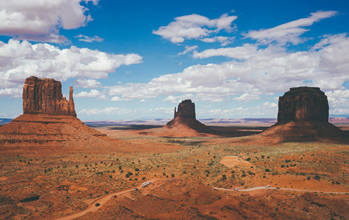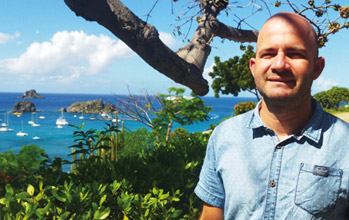 As the Director of the Territorial Agency for the Environment and Curator of the Nature Reserve since 2018, Sébastien Gréaux is strongly committed to environmental issues.
As the Director of the Territorial Agency for the Environment and Curator of the Nature Reserve since 2018, Sébastien Gréaux is strongly committed to environmental issues.
With a master’s degree in Cartography and Bio-production of marine ecosystems at the University of Nantes, Sébastien worked for IFREMER in Martinique for 4 years, then moved to St Barths when the position of marine environment officer at the Territorial Agency for the Environment was created in December 2013. He immediately undertook to defend his native island, where environmental issues are increasingly important and at the heart of its economic development.

 The Territorial Agency for the Environment, created in 2013, assumed all the GRENAT association’s missions, including managing the Nature Reserve. But the Territorial Agency for the Environment is also entrusted with new tasks that affect all environmental sectors:
The Territorial Agency for the Environment, created in 2013, assumed all the GRENAT association’s missions, including managing the Nature Reserve. But the Territorial Agency for the Environment is also entrusted with new tasks that affect all environmental sectors:
 Preserving Fauna and Flora ecosystems in St Barth, both on land and at sea: “We ensure protected fauna and flora regulation, and we give advice on clearing requests. To achieve this, and requested by the Collectivity, we make a census of species on the land. We issue an opinion so elected officials can make decisions with a good representation of the species in place, their protection or distribution status and the possible impacts that certain projects could generate.”
Preserving Fauna and Flora ecosystems in St Barth, both on land and at sea: “We ensure protected fauna and flora regulation, and we give advice on clearing requests. To achieve this, and requested by the Collectivity, we make a census of species on the land. We issue an opinion so elected officials can make decisions with a good representation of the species in place, their protection or distribution status and the possible impacts that certain projects could generate.”
The Territorial Agency for the Environment also monitors the Nature Reserve which protects critical underwater environments and enriches adjacent areas. The Territorial Agency for the Environment also participates in fishing regulations, and many communication, awareness and environmental education measures are implemented.
 “To carry out these missions, I am fortunate to be surrounded by a remarkable, committed and very competent team. 7 collaborators, each invested in specific areas, work in these fields.”
“To carry out these missions, I am fortunate to be surrounded by a remarkable, committed and very competent team. 7 collaborators, each invested in specific areas, work in these fields.”
Beyond these missions, Sébastien Gréaux warns us of the two major risks that St Barths is facing and the two main issues that need to be addressed.
First of all, the issue of goat proliferation. The number of goats is increasing and they all feed on 20kg of vegetation per day. This inevitably leads to the desertification of natural areas and the loss of rare or protected plants, resulting in a strong erosion of the flora diversity. As a consequence, besides the disappearance of species, the earth is no longer retained during rainy episodes and goes to the sea, leading to mud creation and sea bed degradation. This goat proliferation is therefore a real scourge for the island. Over four years, 3500 goats have been captured on the island. However, they remain in very large numbers in certain areas.
 The second threat is stray cat proliferation, one of the most invasive in the world. More and more cats are abandoned, and our tropical climate increases their proliferation.
The second threat is stray cat proliferation, one of the most invasive in the world. More and more cats are abandoned, and our tropical climate increases their proliferation.
This proliferation intensifies the insalubrity of the areas invaded by stray cats. It also leads to the disappearance of sensitive animal species such as birds or reptiles, and in particular endemic snakes which only exist in St Barths and Anguilla. This species is highly endangered. The same is true for other reptiles such as skinks, small lizards also known as batsnakes, or young iguanas.

Since 2012, the Collectivity has set up a free cat sterilization service. Two hundred were neutered by this service in 2012, and now more than 600. However, this measure is insufficient, and other avenues are being considered, such as the creation of a shelter that will keep stray animals safe, chip them and send them to Metropolitan France for adoption.
In addition to these two threats, St Barths authorities are faced with a double challenge:
First, establishing protected land areas. It is about making rules preserving the terrestrial environment that will allow authorities to act on lands without depending on the owners’ approval, whether to remove goats, cats or fight against clearing actions, or carry out replanting actions.
The second issue is to have a better qualitative and quantitative management of rainwater and sanitation. The goal is to set up a master plan to limit as much as possible the arrival in the bays of water loaded with organic matter and pollutants and to have works and rules with the aim of improving the quality of ground water running to the sea.
 Considering the rising number of constructions, cars and visitors, we now need to question the capacity of the island as a whole. How many people can the island support without making it suffer irreparably? How can we ensure the reception of tourists as well as the maintenance of our fauna and flora diversity? What number and size of ships can be accommodated in our bays without harming the sea grass or the reef?
Considering the rising number of constructions, cars and visitors, we now need to question the capacity of the island as a whole. How many people can the island support without making it suffer irreparably? How can we ensure the reception of tourists as well as the maintenance of our fauna and flora diversity? What number and size of ships can be accommodated in our bays without harming the sea grass or the reef?
“This reflection needs to be made by all entities responsible for these topics, but also by each one of us. We all complain that there are too many buildings, too many cars or that they go too fast, but we all have a share of responsibility and a steering wheel in our hands. There are of course political decisions to be made and projects to be implemented but these decisions and projects will hardly stop people from wanting more on an island whose size is fixed. The advantage of being on a small territory is that the impact of a measure or an awareness can be seen very quickly.”
“The environment is a crucial issue for the future of our island. We must all make environment our priority.”
To be followed and supported urgently.



